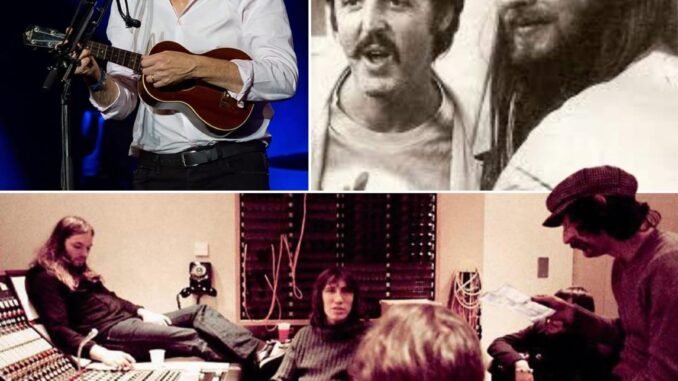
Paul McCartney doesn’t hand out comparisons lightly—especially not to Dark Side of the Moon. That 1973 masterpiece, crafted by Pink Floyd at their creative peak, didn’t just dominate charts; it rewired how musicians thought about sound, space, and soul. It was a record where rock, jazz, ambient textures, and philosophical musings all melted into one seamless listening experience. You didn’t just play Dark Side—you entered it.
McCartney witnessed it all firsthand. By that point, he’d already helped bend the rules of pop with Sgt. Pepper’s Lonely Hearts Club Band, the Beatles’ own seismic shift in music’s evolution. But where Pepper had exploded with color, character, and kaleidoscopic joy, Dark Side moved like a shadow—mesmerizing, heavy, and deeply human. Pink Floyd had taken the idea of the “concept album” and pushed it beyond narrative, into pure emotional immersion. They turned the act of listening into a journey.
For decades, McCartney kept that record in its own rarefied space. He admired plenty of albums, respected countless artists, but Dark Side was something different—almost untouchable. So when, years later, a quiet and haunting modern record stopped him in his tracks, the last comparison he expected to make came rushing to his lips.
It wasn’t nostalgia. This wasn’t the wistful memory of a veteran musician seeing ghosts of the past. This was recognition. The same feeling he’d had back in 1973—the sense that an artist was reaching for the emotional cosmos, painting with an atmospheric brush, and crafting a sonic world you could fall into—was happening again.
The modern album didn’t try to mimic Dark Side’s sonic blueprint. There were no obvious homages, no heavy-handed nods to Floyd’s psychedelic grandeur. Instead, it shared something more elusive: the patience to let a song breathe, the courage to leave space, the trust in the listener to follow subtle threads. It was built like a dream—soft at the edges, vivid in the middle, and strangely impossible to pin down after it ended.
McCartney described listening to it alone one evening, a glass of wine in hand, as the final track dissolved into silence. He realized he hadn’t moved for nearly an hour. The record had unfolded like a single thought, uninterrupted, and when it was over, he felt that rare post-album stillness where reality feels like it’s running a few seconds behind. “It reminded me,” he said later, “of the first time I heard Dark Side of the Moon. Not because it sounded like it—but because it made me feel like it.”
That distinction matters. To McCartney, great albums aren’t just collections of songs; they’re living environments. Dark Side had been a cathedral of sound, every note echoing against invisible walls. This new record—spare, delicate, and modern—was a midnight garden. You walked through it slowly, unsure what you’d see around the next corner, but aware that you were inside something intentional, crafted with care.
In the 21st century, that approach is rare. Streaming culture encourages singles over suites, instant hooks over slow blooms. McCartney’s praise wasn’t just about artistry—it was about defiance. Here was a contemporary musician daring to build an album that required you to stay, to commit, to let it wash over you. It didn’t chase you; it waited for you to arrive.
And perhaps that’s why the Dark Side comparison resonated so deeply for him. Floyd’s record was a product of its time but also timeless—an LP that couldn’t be chopped into playlists without losing its power. This new work carried the same DNA: songs bound together not just by theme, but by an invisible current running underneath. The lyrics whispered rather than shouted, the production blurred the edges of reality, and the silences spoke as loudly as the melodies.
McCartney has long championed the idea that music is an emotional technology—that its real job is to move people, to shift something inside them. The Beatles had done it in their way, Pink Floyd in theirs, and now this younger artist had found their own map to that same destination. The fact that the sound was modern, perhaps even minimalist, didn’t dilute its impact. In fact, McCartney suggested that its restraint might be what made it so potent. “It’s not about how much you put in,” he mused, “but about what you leave out. That’s where the magic lives.”
Hearing him speak about it, you realize the comparison wasn’t a casual compliment—it was a kind of passing of the torch. Not literally, of course; McCartney remains creatively restless, still making records, still chasing ideas. But in this case, he was acknowledging that someone else had found the rare alchemy that turns a good album into an enduring one.
For fans of music history, the moment is fascinating: the man who helped spark the album-as-artform revolution tipping his hat to another artist for carrying that flame forward. And for the artist in question—whoever they may be—there can be no higher praise. After all, when Paul McCartney tells you your work feels like Dark Side of the Moon, he’s not talking about chords or production tricks. He’s telling you that you’ve built a world, and invited listeners to live inside it.
That’s the kind of recognition that outlasts trends, charts, and streaming numbers. Albums like that—whether born in 1973 or today—aren’t just listened to. They’re experienced. They become part of the listener’s inner landscape, places you can return to when you need to remember how beauty sounds.
McCartney has spent a lifetime chasing and creating those moments. And in this case, when he heard it, he knew instantly: this was one of them. It was like hearing Dark Side of the Moon all over again—only this time, the moon was rising in a new century, casting its light on a fresh horizon, and reminding him that the journey through sound is never truly finished.
Leave a Reply